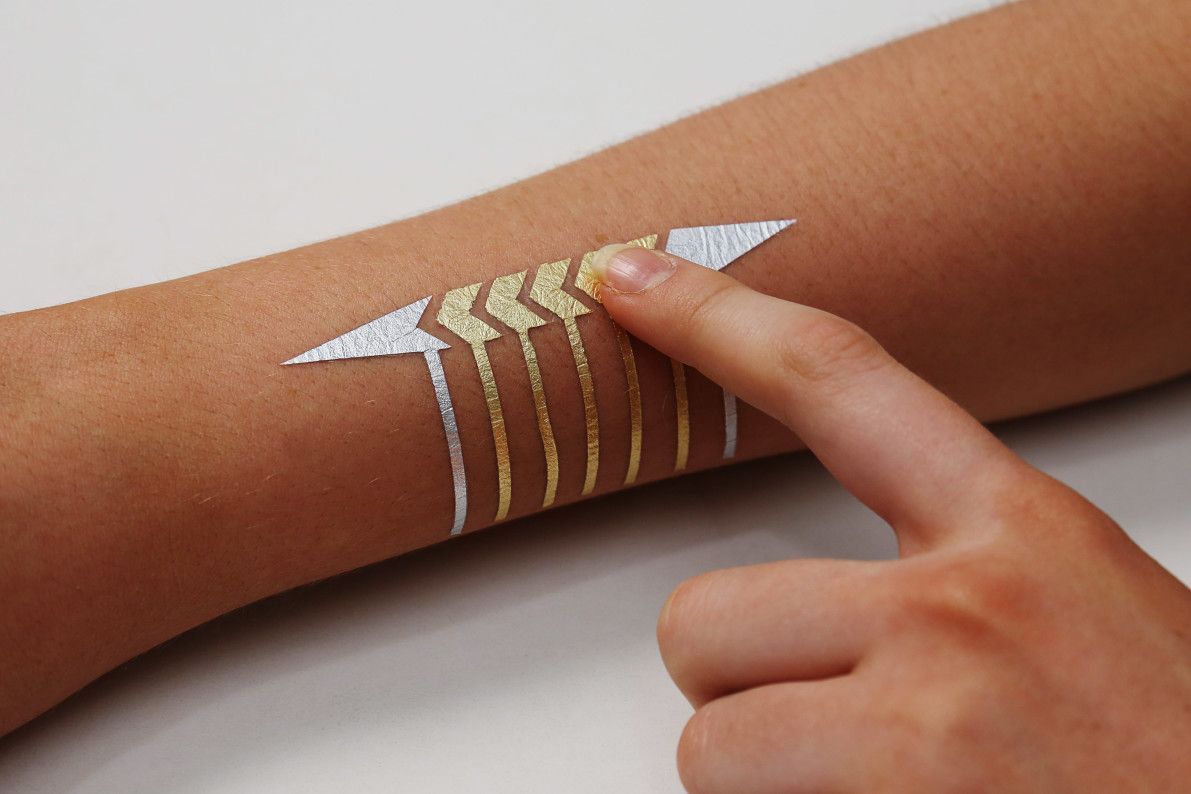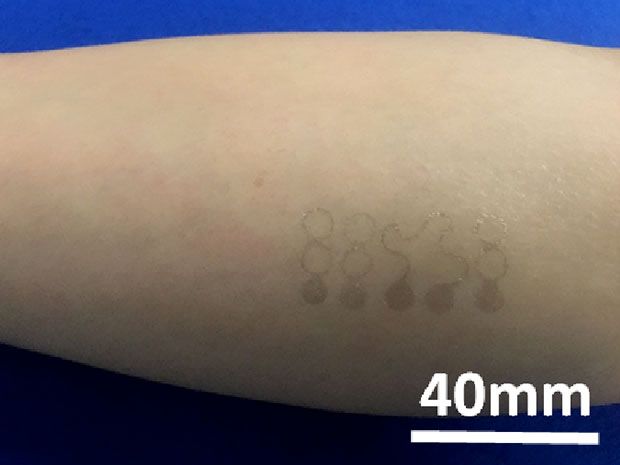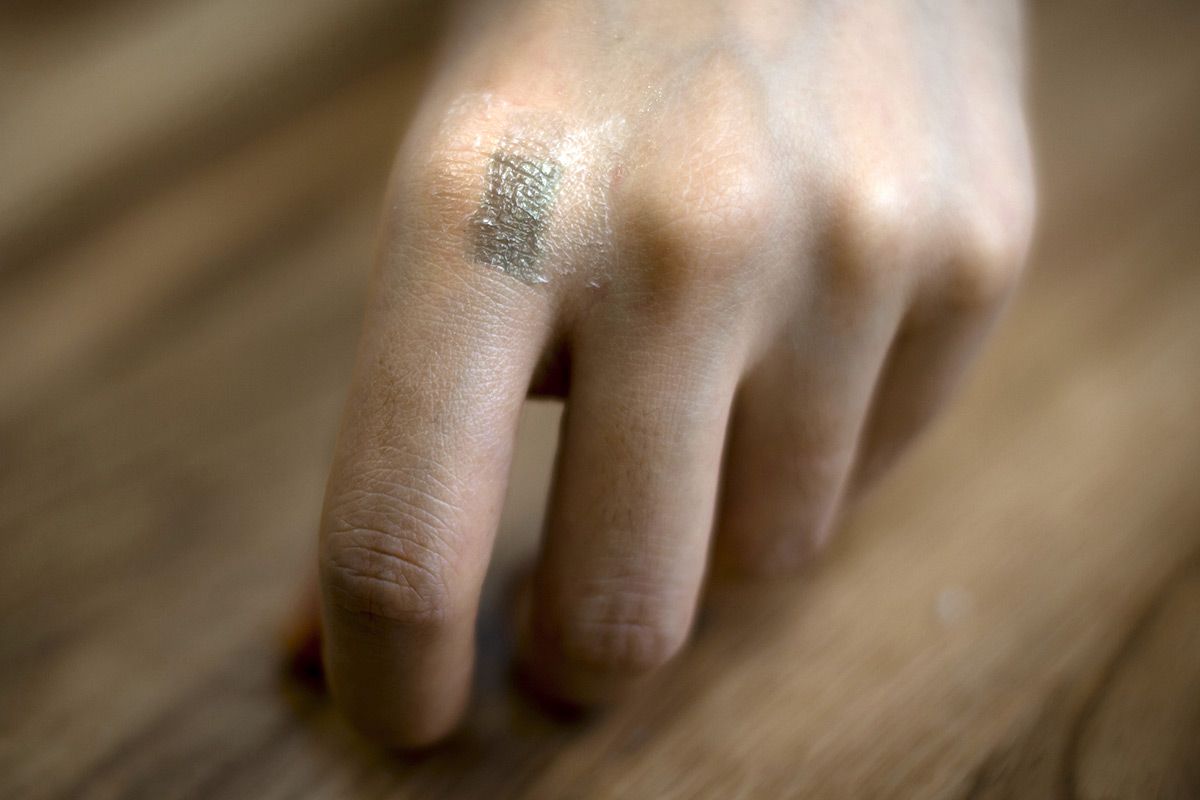Created by researchers at MIT’s Media Lab, DuoSkin represents a new kind of wearable.

Created by researchers at MIT’s Media Lab, DuoSkin represents a new kind of wearable.


The graphene temporary tattoo seen here is the thinnest epidermal electronic device ever and according to the University of Texas at Austin researchers who developed it, the device can take some medical measurements as accurately as bulky wearable sensors like EKG monitors. From IEEE Spectrum:
Graphene’s conformity to the skin might be what enables the high-quality measurements. Air gaps between the skin and the relatively large, rigid electrodes used in conventional medical devices degrade these instruments’ signal quality. Newer sensors that stick to the skin and stretch and wrinkle with it have fewer airgaps, but because they’re still a few micrometers thick, and use gold electrodes hundreds of nanometers thick, they can lose contact with the skin when it wrinkles. The graphene in the Texas researchers’ device is 0.3-nm thick. Most of the tattoo’s bulk comes from the 463-nm-thick polymer support.
The next step is to add an antenna to the design so that signals can be beamed off the device to a phone or computer, says (electrical engineer Deji) Akinwande.
Spinali Design’s line of clothing can be paired with a phone move alerts from the device to your body.
This portable heating system means you’ll never be cold again.


Apple’s first paper on artificial intelligence, published Dec. 22 on arXiv (open access), describes a method for improving the ability of a deep neural network to recognize images.
To train neural networks to recognize images, AI researchers have typically labeled (identified or described) each image in a dataset. For example, last year, Georgia Institute of Technology researchers developed a deep-learning method to recognize images taken at regular intervals on a person’s wearable smartphone camera.

The Happy Headband. Take my money.
The Fisher Wallace Stimulator® is a wearable neurostimulation device that is cleared by the FDA to treat depression and anxiety. During each 20-minute treatment session, the device gently stimulates the brain to produce serotonin and other neurochemicals that reduce depression and anxiety (and support healthy mood and sleep). The device has been proven to be safe and effective in multiple published studies conducted at top institutions such as Mount Sinai Beth Israel Hospital.
Over 6,000 healthcare practitioners, including 2,000 board-certified psychiatrists, have used the device to treat over 20,000 patients since 2009. Most patients experience results within the first two weeks of daily use.

Wearable fitness devices could help you with your personal longevity strategy.
NEW YORK — Activity monitors could improve our health and extend our lives — if only we could be motivated to use them. Those are the conclusions of two new studies about the promise and perils of relying on fitness trackers to measure and guide how we move.
The monitors, which are expected to be a popular holiday gift again this year, can generally track our steps, speed, stance (sitting or not), distance, energy expenditure and heart rate. The absolute accuracy of these numbers, however, is somewhat suspect, with past studies finding errors in many of the monitors’ measurements. But the inaccuracies are usually consistent, the studies show, so the trackers can reliably indicate how our movements change from day to day.
The broader problem with activity monitors has been that we have not known whether the information they generate actually relates directly to our health. We have not had proof that what most trackers tell us is healthy actually is.
Terahertz (THz) radiation is used today most prominently for security screening at the airport. It’s the machine you stand in with your hands up as it swings its scanning arms in front and behind you. In medicine, terahertz imaging has the potential to help diagnoze certain types of cancer and to monitor a variety of health parameters to aid in assessment of overall health. Because of the extremely short length of terahertz waves, this imaging modality has a lot of limitations, including shallow penetration into tissues, and that prevents it from being used more widely. Yet, since it’s non-ionising, it’s probably safe and may even replace dangerous X-rays for some applications.
Currently, terahertz imaging is very poor at scanning curved surfaces even though it can peer a few millimeters deep into some tissues. To overcome this, researchers at Tokyo Institute of Technology have developed a flexible and even wearable terahertz scanner that can image curved 3D surfaces such as our skin.
Made of 23 carbon nanotube detectors that work as a unified imaging array, their device can be wrapped around a finger, for example. Because carbon nanotubes are able to absorb a wide range of terahertz radiation, there’s no need for planar antennas.
You know that whole chaos theory idea (okay, we saw it in an Ashton Kutcher movie) about how a butterfly flapping its wings in one part of the world can trigger a hurricane in another?
Well, the 2016 equivalent is a project where scientists in Russia wear an exoskeleton to control a connected robot in Germany.
Named CAPIO, the project is the work of DFKI, a kind of European DARPA focused on building robots for carrying out applications and tasks that can assist humans. One of its robots is called AILA, and is controllable using CAPIO, an eight-contact exoskeleton system that wearers can use to move AILA in real time.